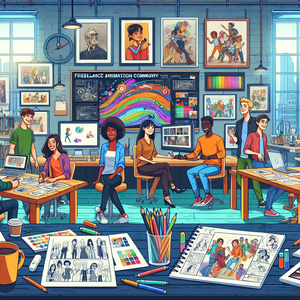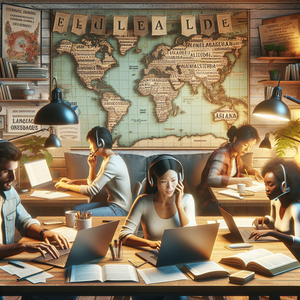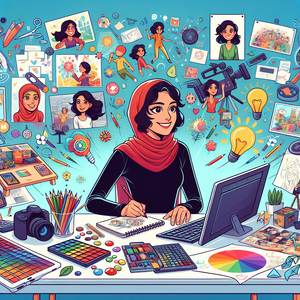
Unlocking Opportunities: A Comprehensive Guide to Thriving in Freelance Animation
The world of freelance animation is a colorful tapestry woven with creativity, technology, and storytelling. For those drawn to visual narratives, this field offers a plethora of career paths—from character design to motion graphics, and both 2D and 3D animation. This guide distills insights into the freelance animation landscape, highlighting the essential skills needed, strategies for breaking into the industry, and a balanced view of the benefits and challenges of freelancing. Success in this vibrant domain demands not just artistic prowess but also technical know-how, business savvy, networking abilities, and the capacity to adapt to an ever-evolving environment. For aspiring animators, understanding these multifaceted aspects is crucial for navigating the competitive yet fulfilling freelance animation journey.
Job Summaries:
Freelance Animator:
- Freelance animators are the heartbeat of the animation industry.
- They craft compelling animations tailored to a variety of clients.
- Mastery of industry-standard software, such as Adobe After Effects and Blender, is crucial.
- The ability to meet deadlines and manage client relationships is important.
- Building a strong portfolio showcasing your unique style and capabilities can significantly enhance your chances of attracting clients.
- This role plays a vital part in fostering innovation within the animation sector.
Motion Graphics Designer:
- Motion graphics designers are tasked with creating captivating animated graphics and visual effects for media ranging from films to online content.
- Proficiency in tools like After Effects and Cinema 4D is essential.
- A keen eye for design principles and storytelling is important.
- Effective collaboration with clients to interpret their visions is key to delivering impactful visuals that resonate with audiences.
Character Animator:
- Bringing characters to life is the hallmark of a character animator.
- This role involves designing character models and ensuring their movements are both fluid and expressive.
- A solid understanding of anatomy and animation techniques is necessary.
- Collaboration with scriptwriters and directors is essential to ensure character development aligns with the narrative.
3D Animator:
- 3D animators specialize in creating three-dimensional characters and environments.
- They use advanced software like Maya or 3ds Max.
- This role demands a blend of technical skill and creative vision.
- It encompasses lighting, texturing, and rendering techniques.
- Their work captivates audiences across various media.
- Their contributions are integral to the entertainment and gaming industries.
Storyboard Artist:
- Storyboard artists play a pivotal role in pre-production by visualizing scenes through detailed illustrations.
- They work closely with directors and writers to translate scripts into visual narratives, requiring strong artistic talent and a grasp of cinematic techniques.
- Their ability to convey emotions through imagery ensures alignment with the overarching creative vision.
Animation Director:
- Animation directors oversee the entire production lifecycle.
- Managing teams and ensuring that projects adhere to artistic and budgetary constraints.
- Strong leadership is essential for guiding projects.
- Extensive animation knowledge is required.
- Effective communication skills are essential for guiding projects from concept to completion.
Visual Effects (VFX) Artist:
- VFX artists create stunning visual effects that enhance storytelling in film, television, and video games.
- Their expertise lies in blending live-action footage with CGI, utilizing software such as Houdini and Nuke.
- This role demands technical prowess, creativity, and the ability to meet tight deadlines while maintaining high-quality standards.
Background Artist:
- Background artists are responsible for crafting the environments that set the stage for animated productions.
- Their work complements the animation style and supports the narrative, requiring proficiency in both traditional and digital painting techniques.
- Close collaboration with animators ensures that backgrounds align with character movements and scene composition.
Animation Producer:
- Animation producers manage the production process from a logistical standpoint.
- They oversee budgets, timelines, and resource allocation.
- Strong organizational skills are essential for facilitating communication between directors, animators, and clients.
- A deep understanding of the animation process is also important.
Educational Animator:
- Educational animators create animated content aimed at enhancing the learning experience.
- They produce e-learning modules and instructional videos.
- Their ability to convey complex information in an engaging manner is crucial.
- Animation is a valuable tool in education.
The freelance animation landscape brims with opportunities for creative professionals eager to make their mark. By exploring various career paths, understanding industry trends, and honing the necessary skills, aspiring animators can build fulfilling careers in this dynamic field. Success hinges on a commitment to continuous learning and networking, essential components for thriving in the ever-evolving world of animation. Whether your passion lies in character design, motion graphics, or educational content, the potential for growth and achievement is vast for those ready to embrace the journey.
Explore More Jobs

